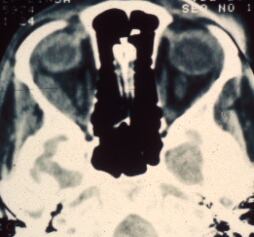Thyroid Eye Disease
|
||
| Thyroid eye disease is one of
the commonest cases in the final MRCOphth, it is important that you know
it well.
It can be presented as a spot diagnosis, orbital examination or ocular motility examination. Spot diagnosis The patient has bilateral (unilateral) exophthalmos with lid retractions. There are also periorbital swellings.Orbital examination The patient has bilateral (unilateral) exophthalmos (do not forget to examine the patient from the side and
This patient has bilateral (unilateral) exophthalmos. There is restriction of upgaze in both eyes (this may be |
Questions:
1. The following is the CT scan of a patient with right proptosis. What
does the scan show?
 |
2. What is the thyroid status in a patient with thyroid eye disease?


